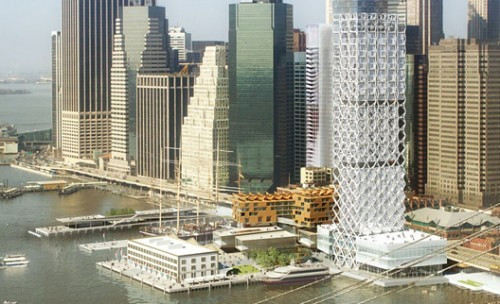SHoP Wraps Green Sheath Around South Street Seaport
Building New York

A rendering of the new Seaport mall. (SHoP)
One of the oldest neighborhoods in Manhattan may soon get closer to nature.
SHoP Architects and the mall operator Howard Hughes Corp. (NYSE:HHC) unveiled an emerald proposal for the Pier 17 mall at the South Street Seaport last Thursday that will ease the historic district into the present.
The glassy design would replace the current brick mall, which adds a solid, if unremarkable, mass to the neighborhood. It bears some resemblance to Brookfield Properties and Pelli Clarke Pelli's $250 million retail renovations at the World Financial Center on Manhattan's Hudson River side that broke ground last month. Rather than replacing the structure, the Seaport's new exterior will encase the existing steel frame.
While the new facade is the most visible element, SHoP's green roof represents the more modern idea.
SHoP and landscape architect James Corner Field Operations plan a multi-use space that would host the Seaport's summer concerts -- currently held at street level -- and offer open space inspired by Boston's Tanglewood Music Center.
Establishing creative open space, particularly along the waterfront, has been one of the mandates of Mayor Michael Bloomberg's administration, and SHoP's design encompasses that principle, expanding on their work at Pier 15.
The arrangement is also reminiscent of Chelsea's High Line, the elevated park that evolved from old railroad tracks, and challenged gritty industrial stereotypes of the area. James Corner was also involved with the High Line, along with Diller Scofidio + Renfro. (Renderings for the High Line's third phase were released Monday.)
But while the High Line has fundamentally transformed the neighborhood, SHoP's design at the Seaport rides an existing wave change.
The Seaport, which juts out from the eastern edge of the Financial District, remains filled with 19th century Greek Revival and Romanesque buildings. But since the 1980s, its notion of commerce has bulked up, when the Rouse Company, headed by James Rouse, built the South Street Seaport mall and splashed Pier 17 in white paint along its exterior.
Even as numerous proposals failed -- in 2000, Frank Gehry designed a museum for the Guggenheim, but the project was never built -- the area would feel the shockwaves of the 9/11 attacks and subsequent residential resurgence of the surrounding Financial District.
The green roof has a performance space and parkland. (SHoP)
In the wake of the attacks, a mix of public and private entities, including the Downtown Alliance, Lower Manhattan Cultural Council, Port Authority, commercial real estate brokerage CBRE and American Express would partner to found the River to River Festival. The festival has offered free music, art and culture from the Hudson to the East River each year in the last decade. And the Seaport became the unlikely nexus of emerging independent music, with bands like the National, the xx and Animal Collective perfoming under the swaying masts of historic ships.
The more recent crisis of 2008 affected the Seaport in a less visible way. General Growth Properties Inc. (NYSE: GGP), the second-biggest U.S. mall operator, underwent bankruptcy in the wake of the credit crunch and spun off Howard Hughes Corp., whose chairman is hedge fund titan Bill Ackmanwhich and which now owns the Seaport. (In January, General Growth also spun off its weaker malls under the company Rouse Properties, a tribute to the original developer.)
Meanwhile, local changes continue: the Seamen's Foundation sold its headquarters at 241 Water Street to the Blue School last year, and the South Street Seaport museum was acquired by the Museum of the City of New York, reopening in January after financial problems. The cobblestone streets now ring with the sound of a Bodies exhibit, boutique retail and a beer garden.
An earlier plan, now abandoned. (SHoP)
SHoP's new design is a retreat from the high-density master plan floated a few years ago by General Growth. It focuses on the retail portion, leaving the historic Tin Building untouched, although Howard Hughes Corp. may eventually revisit those sites in the future. Still, the attention to open space and its relation to the public represents the enlightened urbanism of the 21st century, and a stark contrast to the canyons of skyscrapers that loom to the west.
The new proposal must navigate the city's extensive land use approval process and would be completed by 2015 at the earliest. But regardless of its fate, this summer, the waterfront will come alive with culture and music.
© Copyright IBTimes 2024. All rights reserved.





















